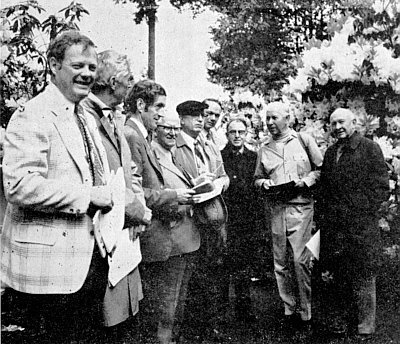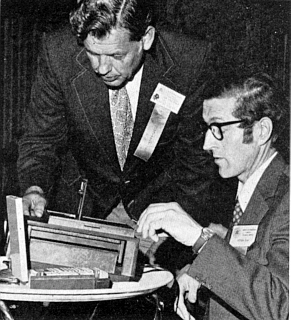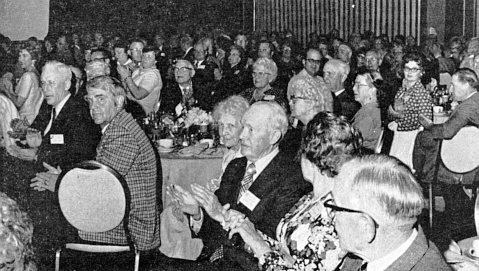QBARS - v28n3 President's Address 1974 Annual Meeting
President's Address
Annual Meeting, ARS, 1974, Portland, Oregon
Alfred S. Martin
|
|
|||||
|
||||||
The relatively swift passage of time as we get, older seems to make progress in accomplishing projects infuriatingly slow. We haven't always moved as rapidly over the past year's we would have liked, but some progress has been made. Most of the good work has been clone by strong committees and dedicated committee members.
Top honor for the most far reaching and monumental project goes to Mrs. Hugh Baird of Seattle and her Twenty-five Year Index Committee. For all practical purposes, the first twenty-five five years of the Quarterly Bulletin have now been completely indexed and the future value to the Society of this work cannot be overestimated. This valuable work will be published before the end of the year and made available not only to our own membership, but to other organizations and libraries. Cost of the publication will preclude free distribution of this Index but it can be sold at a modest cost along with other of the Society's Publications. The Board of Directors at their May meeting gave enthusiastic preliminary approval to funding this project. Since 1973 has already been indexed by the editor, only 1971 and 1972 will remain un-indexed and I hope that we can look to Mrs. Baird and her committee to fill this.
Our registrar, Mr. Edwin K. Parker, has been especially active and hard working. His correspondence file is reaching major dimensions. All of us owe a great deal of gratitude to Ed for herculean efforts in working with individual members, the International Registrar and the Plant Records Center.
What can one say about Esther Berry and the Seed Exchange that has not already been said in the past. There are many in the Society who feel that in the years to come this one thing may well be the most significant accomplishment of the Rhododendron Society in this decade. One of Esther's main concerns at the minute is the hope that the growing tendency toward Chapter Seed Exchanges will not sap the vitality of the national program.
The Annual Meeting Committee with Dr. John P. Evans of California and Dennis Stewart of New York has been especially active making it possible to schedule meetings through 1979. Uncharacteristically the Board has had to make difficult decisions in selecting sites from multiple choices. With action taken at the last meeting by Board approval the 1975 meeting would be held in Seattle, the 1976 meeting in Philadelphia (200th) the 1977 meeting in Eugene, the 1978 meeting in New York and the 1979 meeting in Vancouver.
The Native American Species Committee has undergone a complete metamorphosis over the past year under the chairmanship of Fred Galle of Callaway Gardens. It is now called the Azalea Committee with three sections: Evergreen Azaleas chaired by Dr. Franklin West of Philadelphia, Native Azaleas headed by Fred Galle and Deciduous Hybrids and Species. This committee has been very active in promoting literature for publication in the Quarterly Bulletin and it is our hope that over the coming months a minimum of one article on evergreen azaleas will be published in each Quarterly along with additional material from the other sections.
We have also had a very active Editorial Board over the past year headed by Jock Brydon. Due to the efforts of many people, our editor Molly Grothaus, has been able for the first time to accumulate something of a surplus instead of a shortage of material for the Bulletin. I believe that this is probably the first time that an editor has had the problem of selectivity rather than quantity. It would be perfectly superfluous for me to make any comments on the Quarterly Bulletin itself and I have heard nothing but excellent remarks on the publication and certainly this has to be the direct result of Molly's outstanding efforts as an editor who has devoted almost full time to this project.
The Ratings Committee headed by George Clarke and the Publications Committee chaired by Bob Ticknor are working hard to complete the next volume for publication by the Society on American Hybrids. This new book should be published prior to our next annual meeting in Seattle. Incidentally, a group in Philadelphia headed by Dr. Franklin West and Philip Livingston, is planning to bring out a new book devoted to the work of Eastern hybridizers sometime during 1975. Among the hybrids covered would be the Dexter hybrids and the work of Guy Nearing, Tony Shammarello, Joseph Gable and B. Y. Morrison.
Special mention must be made of the preliminary work being done by the Research Committee under the general chairmanship of Dr. August Kehr, our Eastern vice-president. The fundamentals have been put together and now it becomes the job of the Society to determine how far we want to go in the field of sponsoring active research. Dr. Kehr and his committee have presented an interesting group of twenty-eight possible projects to the Board. Funding the minimum amount of $6,000 over a three-year period was approved at the May meeting. The funds will come from the designated Educational Fund of the Society and not from Current Income. The Middle Atlantic Chapter, sparked by Harry Nash has undertaken its own two-year research project, "The determination of the causes and control of dieback and wilt of rhododendrons grown in zones 6, 7, and 8 of Virginia." This project is being directed by Dr. R. C. Lambe of Virginia Polytechnic Institute and State University Blacksburg. Both the New York Chapter and Potomac Valley Chapter have also instituted ambitious and valuable azalea projects. Through the efforts of Dr. Kehr and Mrs. Jane Goodrich of the Potomac Valley Chapter, the proceedings of the first Rhododendron Breeders' Roundtable in Pittsburgh are now in final form for publication and sale to interested persons. The publication of 500 copies of these proceedings was authorized at the May meeting of the Board on recommendation of the Publication Committee.
Dr. Ned Brockenbrough of Seattle and Dorothy Schlaikjer of New York have a firm grip on the Society's Awards program. I am also glad to report that Betty Hager of the New York Chapter, the chairman of the Shows and Judging Committee, will soon have a recommended manual for any chapter wishing to avail themselves of this type of assistance. There is no such thin as a national policy on Shows and Judging, but a suggested guide would be helpful to many chapters.
Ted Van Veen has headed a very strong Honors Committee this year in line with our belief that national and not local emphasis should be the guiding factor in the awarding of the Society's Gold and Silver medals. Howard Short fortunately has continued his devoted work to the Slide Library and with the new programs being developed, more chapters than ever should avail themselves of this service.
Our greatest emphasis over the past year has been the attempt to establish better lines of communication between the national society and the individual members and chapters. The results of the balloting on the by-laws and the current election of directors would indicate that some progress has been made. Almost a quarter of the membership participated in the balloting for the election of directors to take office this year. This was considerably higher than it has been for some time in the past.
Directors elected for three-year terms were: Esther Berry, Grays Harbor Chapter; Dr. E. C. Brockenbrough, Seattle Chapter; George W. Clarke , Portland Chapter; and Henry A. Schannen, Valley Forge Chapter. Our personal thanks should go to all the nominees for their interest in the affairs and direction of the Society. With the quality of the nominees, it seems a gross misfortune that they cannot all be elected.
We were delighted that a third of the membership responded to the January Questionnaire. A preliminary report has just become available and a full report on the results of this survey will be in the October Bulletin. This survey should be extremely important to us in assessing our immediate and long-term goals for the Society. The final results will help thinking and planning for almost every facet of the Society. After all, the main reason for our existence is to best serve our membership. We were fortunate in being able to have this rather expensive survey funded by interested individuals and foundations. The cost would have been prohibitive for the current income of the Society.
I am delighted to report the substantial completion of another public interest project. Just before leaving for the May Board meeting, I signed the final papers for the Group Exemption Application of the Society and its chapters under the provisions of the revised Internal Revenue Code of 1954 as amended. What started as a seemingly simple operation turned out to be exceedingly complicated. Few, if any, plant societies have a group exemption under the Code. Arthur Young and Company filed our application under Section 501 (c) (3) which provides the broadest possible coverage of the nineteen possible sections. Section 501 (c) (3) covers corporations funds and foundations organized and operated exclusively for religious charitable, scientific, literary or educational purposes. One of the tests under this section is the amount of public support received by the organization. Approval under this section of Section 501 (c) (c) (1-4) would provide full deductibility for tax purposes for any gifts or bequests to the Society and its chapters. Currently some of the chapters are approved under Sections 501 (c) (6-19) which do not provide the protection. Hopefully, the Service will rule on the application favorably before the current year is over. This work was completed through private funds and the cooperation of the Philadelphia office of Arthur Young and Company.
Today the Society is really at the crossroads. We can remain as many members rightfully wish, a good socially and chapter oriented society gathered exclusively to talk about rhododendrons and watch the world go by. Alternately, we can become a cohesive force to promote the fundamental aims of the Society's founders and try to influence the environment that surrounds us with all possible determination. The second choice is neither an easy nor a comfortable one. During the past year, I believe that the officers, directors and committees of the Society have shown that work and responsibility are not foreign to their nature.
Back in 1969 in his final presidential remarks at Callaway Gardens, Edward Dunn listed a number of primary consensus objectives for the Society. These included a permanent office, expanded membership, increased publication activity, increased investment in research studies, establishment of a Society Library, sponsorship of plant explorations and scholarship aid. Few of these objectives have been substantially implemented nor are they likely to be completed at our present level of operations. The current revenues of the Society at this point are barely capable of maintaining the status quo without regard to inflation and rising costs. The financial report looks healthier than is really the case since the funds shown in the United States National Bank and Oregon Mutual Savings are restricted usage accounts for annual meetings, publications and education.
At the national level, the current dues structure yields seven dollars per member. The bulk of this is returned to the individual members through the Quarterly Bulletin. Despite substantial economy measures by the Editor this year, the cost of the Bulletin is rising and will continue to do so next year in all probability. Without breaking down fine details, it would appear that it is costing the National Society approximately $5.00 annually to furnish the Quarterly Bulletin to each member.
Other fixed expenses such as telephone, stationery, postage, auditing and legal fees, payroll taxes, executive secretary's salary will add somewhere in the vicinity of $1.85 per member annually. Obviously, this leaves little cushion even at current level of operations.
This is the problem that the current Finance and Budget Committee is working hard to resolve. A final report will be ready for the fall Board of Directors' meeting. If only we were a political entity, it would be simple to promise all of you more service and less taxes.
Fortunately, there are a good many viable programs that can be considered as possible alternatives to raising dues. Both the Finance Committee and the Board considered many of these at their recent meeting. It was a good time since there were forty-six out of the fifty-five possible members present. All but nine of our thirty-eight chapters were represented. It was something beyond my wildest dreams and almost double any previous meeting I can remember in the past decade.
Many of the best suggestions would require a change in the by-laws which would mean that fiscal 1976 would be the earliest possible date for implementation. These included dropping chapters' share from $3.00 to $2.00 which, considering the number of chapters present at the May meeting, enjoyed relatively strong support. Another suggestion was to change the classes of membership to include individual, family, sustaining, contributing, sponsor and life. This would provide tax-deductible shelter for increased individual support. Also discussed was changing the fiscal year date to September 1.
One of the finest methods of increasing income would be by increased membership which automatically decreases the cost of overhead and publications per member. After all, our membership has remained static for some time while interest in our aims has grown. The Quarterly Bulletin could also safely carry more advertising and reduce the per-issue cost.
The treasurer will take immediate steps to review the income derived from savings deposits and if advantageous, will move the money into short-term and medium-term government obligations to insure maximum return. The success of all of our programs rests ultimately on you, the individual members. You are the Society and we exist solely as your corporate instrument. Without your backing, we are nothing. We are working hard to formulate programs aims and objectives cooperatively and in consonance with your desires. We do not like to follow the adage that silence gives consent. Speaking for the officers particularly, we want to hear from you at any time negatively or positively but hopefully constructively.
In short, all of your officers and directors look forward to the coming year with anticipation that progress will continue and that the next annual report may show substantial achievement toward both long and short-term goals, and make this group of great people the best and most service-oriented Society possible.



